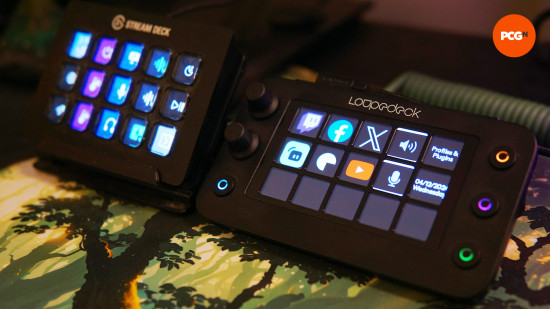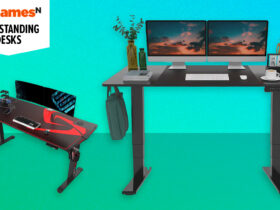Our Verdict
The Loupedeck Live S shoots for the stars but lands on the moon. Its sturdy construction houses every feature you need for even the most complex workloads, and its excellent pre-configured macro profiles will save you a ton of time (and potentially money) setting it up. However, it doesn’t take long to stumble into software performance craters that sometimes render it frustrating to use.
- Versatile all-in-one deck
- Amazing pre-configured macro profiles
- Can be laid flat
- Software struggles
- Competitors offer more for streamers
- MX Creative Console offers more for creatives
Having gotten hands-on with the Loupedeck Live S for my review, I checked out what the Loupedeck Live’s smaller sibling had to offer in an incredibly competitive market dominated by Elgato. While the deck’s feature set is replete with every feature I could possibly want, its execution is a step below the competition.
The Loupedeck Live S – the small and mighty version of the Loupedeck Live – is an all-in-one macro system for creatives. You can even stack multiple macros into one command, unleashing a chain of automation that can dramatically improve your quality of life. Of course, this is ubiquitous across all the products competing to be the best stream deck right now, but Loupedeck’s in-built macro profiles for these programs really drew me to it in the first place. If I’m going to be lazy – I mean efficient – then I want to do it properly.
Why you can trust our advice ✔ At PCGamesN, our experts spend hours testing hardware and reviewing games and VPNs. We share honest, unbiased opinions to help you buy the best. Find out how we test.
I was mildly confused when Logitech officially entered the stream deck arena after snapping up Loupedeck’s eponymous creator in 2023. No, it wasn’t because the peripherals giant wanted to steal Elgato’s thunder – that much was understandable.
It was because the firm had just acquired a brand that had already pretty much given one of its headline products, the larger Loupedeck Live, to rival Razer in the form of the Stream Controller. Additionally, the rebadged device runs on Loupedeck’s software, so anything Logi would do to improve the Loupedeck Live (and by extension, the Live S) experience would also benefit a direct competitor.
By the looks of the situation, though, the deal between Razer and Loupedeck is now off, as trying to get hold of one of these collaborative decks nowadays is a bit like trying to get blood out of a stone. Additionally, Logitech has created an internal schism between Loupedeck’s software and Logi Options+, the new driver for the flashy MX Creative Console it launched in October 2024.
The good news is that the Loupedeck product line hasn’t been sentenced to quiet obsolescence, and if anything Logi’s support has revitalized it, when it works. Whether you’re trying to make a name for yourself on Twitch, or are looking to amplify your workflow with shortcuts in programs such as DaVinci Resolve and the Adobe suite, there’s a lot to like here.
Specs
Loupedeck Live S specs:

Design and features
Sitting at just 5.9 x 3.4 x 1.2 inches, the Loupedeck Live S sits a smidge taller than my iPhone 13 Pro. Despite its all-plastic construction and thinness, the device has very little flex, so I’m confident in the quality of the materials despite it being so light. I wish I could say the same for the attachable stand’s structural integrity – a spindly cradle that looks like it would get snapped in two by a stiff breeze. It’s also a bit finicky to attach, though saying that I have the poise and finesse of a raging bull, so I’m sure you’d fare better. Fortunately, I was most interested in testing the Live S flat, so this wasn’t a deal breaker for me.
On the fascia of the Live S, you’ll find two pushable dials, four circular RGB buttons, and an LCD touchscreen divided into a five-by-three grid of buttons. The mechanical components are suitably robust – the dials provide a slight resistance with every tick and press, while the buttons have a shallow press, which is ideal if, for some ungodly reason, you’re trying to speedrun the cycling of your macro pages without wasting excess energy.
The two dials don’t carry the same dial stacking capability as Elgato’s Stream Deck +. However, you can still cycle through multiple functions for a single dial by swiping vertically on the touchpad – provided you’ve set it up to do so.

As for the buttons, bizarrely the single button on the bottom left of the unit can be tapped or long-pressed, while the three on the right-hand side can only be assigned a tap function. Even more peculiar is that the long press isn’t customizable and only returns the device to its main profile. Reading around, I did see that there were plans at launch for these buttons’ functions to be expanded, but it’s clearly fallen by the wayside.
The show’s star, the touchscreen panel, is bright enough that you won’t be reaching for a torch to make out the icons. It’s equal to my Elgato Stream Deck MK.1 (ol’ reliable) in this regard, as it is when it comes to icon legibility. Both have a subtle smeariness to them that you won’t find on the more expensive Stream Deck +, but even the tiniest text remains readable.
You’re greeted with a weak haptic buzz when you long-press a touch button, but lighter taps won’t elicit this response, even when the action is registered. It’s sufficient for the job, but I still much prefer the feel of the real buttons on my MK.1. The touchpad accepts swipe gestures, so you can scroll through macro pages without sacrificing whole buttons. Though I long for analog, this digital approach adds functional flexibility.

Another big design win is that you get the dials, buttons, and 15 whole macro keys all in one package – an area where Elgato has continued to skimp, even with its most premium offering. That said, the Loupedeck can’t top the crisp LCD touch bar and metal rotary encoders that the Stream Deck + provides. As a halfway house between the 15-key Stream Deck and the Stream Deck + in terms of price, the Loupedeck has found its competitive niche – at least when it comes to the outer shell.
The Loupedeck only comes in black, so if you’re after an all-white setup I’m afraid you’re out of luck. I’ve looked on both the Loupedeck site, and third-party storefronts such as Ets,y for custom face plates, but to no avail.
In the box, aside from the stand and a quick start pamphlet, you’ll find a braided 2m USB-C to angled USB-C cable with an attachable USB-A converter at the PC end. However, on the unit I reviewed, I often found I couldn’t adjust the position of the deck without it momentarily disconnecting because of the way in which the angled end levers.

Software and performance
A stream deck lives and dies by its software, and the Loupedeck’s is hit-and-mostly-miss. The Loupedeck app is intuitive and well-presented. The UI is clean and easy to parse while assigning and editing commands takes little work. I had seen a lot of earlier feedback from users regarding the software’s unapproachability, so it’s clear both Loupedeck and Logitech have been putting in the work to get it up to par.
At the top of the nav, you’ll find three chunky drop-down menus: one to select your device, one to choose which app profile you want to use, and one to pick a workspace (toolbox) you want to use while in that profile. I didn’t often need to use workspaces, but the 14 pages of buttons and dials are there for that extra layer of granularity. The Live S supports dynamic profile switching too, so you’ll always have the right page for your active desktop window in view.
In the top right corner, you’ll find a shortcut to the Loupedeck Marketplace – your one-stop shop for profiles, plugins, and more that are regularly updated. While it doesn’t offer the same menagerie of wonders as Elgato, it’s infinitely more free-to-play. Logitech continues to provide free macro profiles for productivity tools such as the Adobe suite, DaVinci Resolve, and Notion (many of which are pre-installed), alongside dedicated game shortcuts for the likes of Baldur’s Gate 3, Euro Truck Sim 2, and World of Warcraft.
Elgato’s third-party-made variants all require coughing up your cash, to the point that you’re looking at over $100 just for the aforementioned programs and games. Logitech and Loupedeck have set a standard that I have long been hopeful Elgato will eventually match.

While roaming Azeroth in WoW Classic I was pleased to find all the shortcuts I needed for marking targets, emoting (sans /spit), and quickly accessing skill menus. The emotes even come with delightful gif icons showcasing the action – nice touch. Annoyingly, though, using a macro would spawn an egregiously large pop-up box over the game, and I’ve been unable to find a way to disable it. This, unfortunately, is where my Live S performance woes begin.
Photoshop is one of my most-used apps, and actually getting the plugin working so that the two programs communicate took some serious troubleshooting. Between wonky versions causing compatibility issues and random disconnects, it’s been anything but the plug-and-play experience I expected. When it has worked, though, I’ve had a fabulous time quickly switching through tools and adjusting values using the dials.
Sadly, my biggest dealbreaker has been the Live S’ general performance. Between slow profile switching when tweaking commands in the app, major hanging to the point that multiple commands execute simultaneously, and even total freezing occasionally, it’s been a huge source of frustration. I’ve reinstalled the app a couple of times just in case, but the result has been the same.

Should you buy it?
- Yes: if you don’t want to spend hours programming macros for productivity apps.
- Yes: if you want to use a stream deck flat against your desk.
- Yes: if you want to use the stream deck for streaming, editing, and more.
- No: if you’re already in a competitor ecosystem.
- No: if you have a low tolerance for software foibles.
- No: if touchpads aren’t accessible enough for your needs.
If the Loupedeck Live S isn’t for you
Elgato Stream Deck MK.2
A 15-key Stream Deck from Elgato is ideal if you want to keep your setup simple. Clocking in at roughly $30 less than the Loupedeck Live S, the Elgato Stream Deck MK.2 is the perfect companion if the dials and do-dads don’t do it for you. You’re also benefiting from Elgato’s best-in-class software.
Elgato Stream Deck +
The eight-key, four-dial, touchbar Stream Deck + from Elgato is ideal if you’re after the best of the best. For an extra $20, you can opt for the most comprehensive stream deck on the market. The Stream Deck + boasts immaculate build quality and Elgato’s best-in-class software.
Nowadays, you can also pick up attachable accessories, such as an XLR dock and a USB hub that transform it into the ultimate all-in-one setup for streamers and general content creators alike. While the Live S still wins out on raw value, due to its library of free macro profiles, the Stream Deck + gets the nod from us if money isn’t an issue.
Read our full Elgato Stream Deck + review.
Verdict
At a surface level, the Loupedeck Live S has every feature you could possibly want from a stream deck. Its solid hardware package comes with all the bells and whistles any creative could need, while its extensive in-built macro profiles provide a remarkable amount of value. It’s a dream to use when it works, but a litany of software issues and the odd implementation foible make it hard to recommend readily.
Price-wise, it slots neatly between Elgato’s most popular and most premium products, making it a worthy competitor in a near-monopolized market. Should Logitech continue to iterate effectively on the brains behind the Loupedeck line, then it could become a much more compelling package – especially for editors and power users.












Leave a Reply